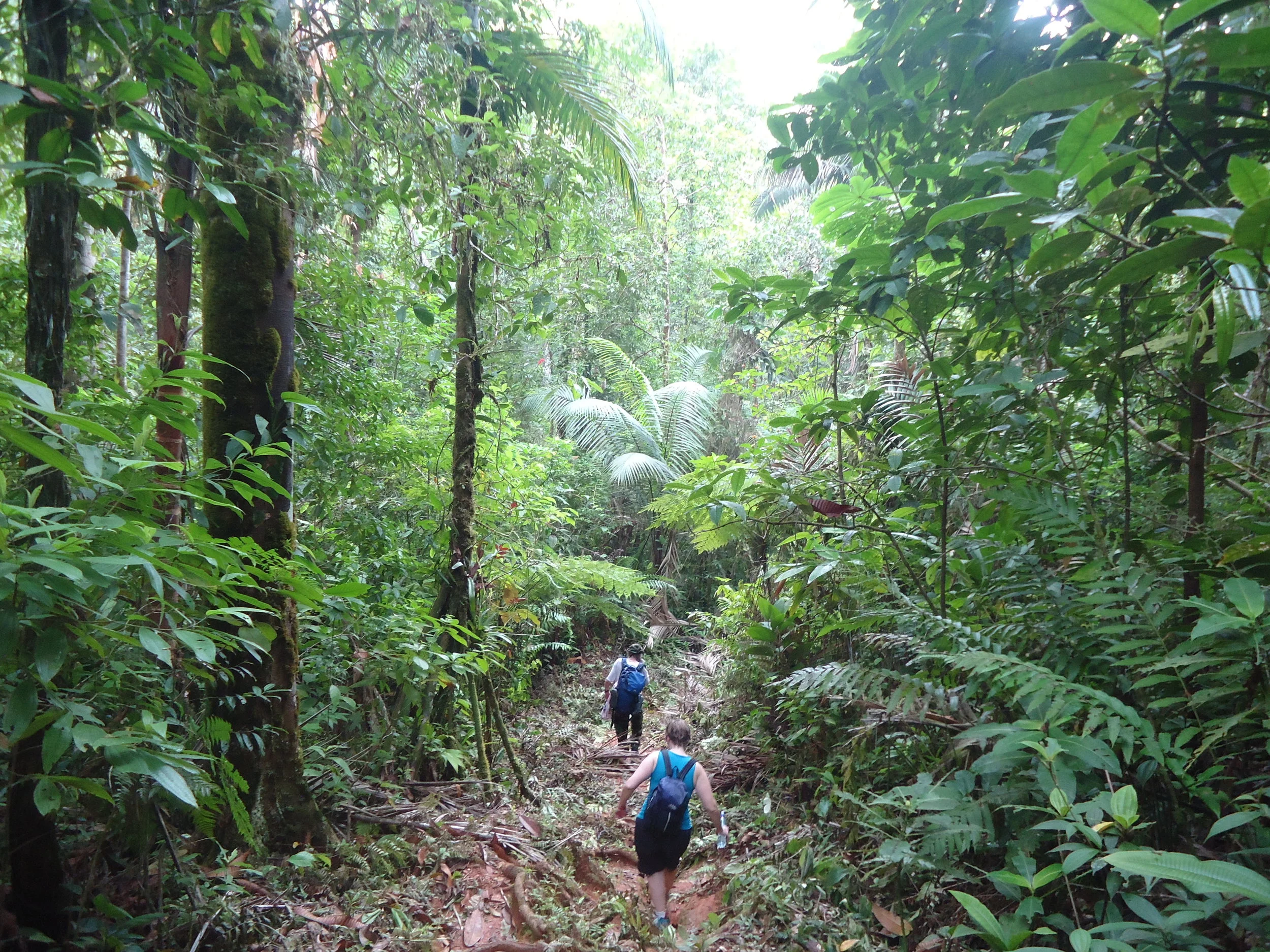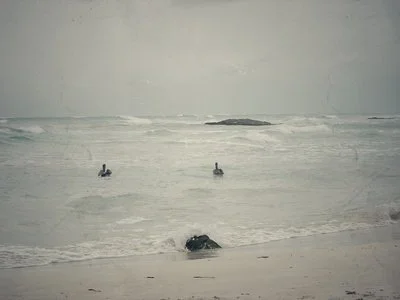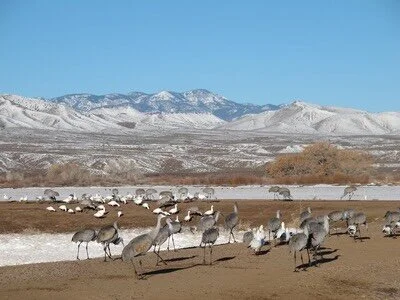Launching a small-scale drone program to aid the fight against wildlife poaching in northern Tanzania presents challenges beyond the technology for Mike Chambers and a team at Mkomazi National Park.
All in Eco Travel
The travel writer’s dilemma
Travel writer Deborah Gray used the pause in travel of the past year to consider how the tourism industry can move forward more consciously and her role in the bigger post-pandemic picture as a traveler and journalist.
Costa Rica and the Trek of a Lifetime
After emerging from a sweltering jungle trek in Costa Rica, Dina Lyuber saw herself in the mirror for the first time in three days. Her face was sunburnt and sweat-stained. She felt achy, exhausted, and surprisingly exhilarated.
Out on the Edge Above the Arctic Circle
Past and present collide in unexpected ways when 80-year-old Gary White embarks on an arctic adventure to celebrate his wife's birthday and is forced to face his perception of the arctic as a dangerous and primitive place, a deeply embedded fear, he realizes later, formed as a ten-year-old boy.
Hidden Philippines: Tropical Mountains Beyond and Above the Beach
There's more to the Philippines than white sandy beaches, clear blue ocean, soothing waves, and swaying palms trees. When American expat BJ Stolbov settled in the Philippines, he traveled beyond and above the tourist-laden beaches to a world of lush tropical mountains and indigenous tribal culture and people. Discover his insider tips for exploring the mountains of northern Luzon.
Written in Stone
A visit to Arches National Park inspires this reflective essay on the powers that shape, pare, trim, and mold this unique region of the American Southwest and the relationship to how time molds our eroding bodies and identies.
A Kayak Pilgrimage
by Dan Dworkin
To travel solo for days in a kayak is to be not on or in but of the water. It loves you, rocks you like your mother did, speaks to you with many voices, supports your meandering, bathes you, feeds you, tells you when to travel and when to stay still on the island of the moment. On every trip there is a time of storm, of being wind-bound when the judicious kayaker stays put, writes, rests, wanders, constructs stone sculptures and listens for the still, small voice.
Bhitarkanika Sanctuary: An Indian Getaway Into the Wild
The darkness of the night and the troublesome roads were worrisome, and at first it was a relief to get out of the car, but then the destination itself proved to be a scary proposition. Our ferry in the moonless night looked sinister. And when we thought about the fact that we had entered the terrain of ferocious crocodiles, the scene in front of me seemed straight out of the famous Anaconda movies. The lone lantern lighting the boat and the stillness of the water around us felt menacing. At first, most of us laughed to ward off our fear.
And then none of us spoke. Did we fear waking the reptiles? I do not quite know for I had become too numb to think coherently. Do not mistake me; I am not one of those who succumbs to fear very easily. But when it came to the prospect of being eaten by crocodiles, my mind became my own worst enemy. I kept repeating to myself that the creek was full of salt water crocodiles and I kept replaying the visuals of the Anaconda movie. In retrospect, and with objectivity, I can say that the boat ride was actually peaceful and serene.
Fire, Candle, Drum, and Stones: A Sensory Experience
The first thing I heard were sounds. Were they cymbals? Was it thunder? What did they mean? Were they supposed to mean something? But I didn’t have time to ponder before the next sensory assault -- this time different textures caressing my bare feet -- gravel to burlap, wooden slats to smooth slate to soft rug. Were the others experiencing the same thing?
And here’s the rub. We were all blindfolded, one hand on the shoulder of the person in front of us, as we moved about our mini-jungle. At first, I felt disoriented, out of control, with the added annoying question lurking in the back of my head: I am a travel writer, how am I supposed to take notes? But our Mayan guide propelled me back into the moment by explaining that when our sight -– our main sense in relating to the world around us –- is cut off, the others senses are expanded. And I had better start paying attention.
An Expert Hacker in Amazonia
I am a hiker. But at home, no one uses a machete to blaze the trail prior to walking on it as Souza, our Amazon guide, did, creating a path in the overgrown rainforest step by step. Slicing, swatting, swooping, chopping, no branch, bush, vine or twig was safe.
The hike was one of four daily activities during an 8-day adventure exploring Amazonia. Calling the Tucano, a 16-passenger riverboat, home, my husband and I traveled more than 200 miles along Brazil's Rio Negro. For daily excursions, we clamored aboard a small power launch which took us hiking, bird-watching, and village hopping, and on night-time outings that dramatized the allure of the river not experienced in any other way.
A Wild Ride in the Dominican Republic
First things first. No water slide at any man-made water park will ever be the same again for me –- not after cascading down natural waterfalls in the Dominican Republic.
The Primeval Waters of Bahia de Ascension
On the first trip I made with my family to the Yucatan in 1973, tourism was virtually unknown. It was prior to the building of the Cancun airport and the only people who ventured down to this part of the world used cars or trucks on the little-traveled roads. Those existing roads were rarely paved once you got off the main two-lane highway.
The Bosque Is For The Birds
words + photos by Laurie Gilberg Vander Velde
“Maybe I will go to the car and get my tripod,” I said to my husband. We were at the edge of a mostly frozen pond, standing on snowpack, bundled up against the 19 degree cold in the pre-dawn dark. A glimmer of light was starting to show in the sky. We had staked out a spot in the line of tripod-wielding photographers with their mega-humongous lenses We were all waiting for the awakening snow geese and sandhill cranes to perform their morning “fly out.” We were at Bosque del Apache, a National Wildlife Refuge near San Antonio, New Mexico about an hour south of Albuquerque. It’s a place known to many serious bird watchers who throng to the area in the winter to watch thousands and thousands -- and thousands of snow geese and sandhill cranes come and go.
 We are not avid birders, nor am I a zealous photographer. How could I be? I love taking pictures and dabble in PhotoShop, but I tote a point-and-shoot camera. It’s top of the line and somewhat flexible, but it’s still a point-and-shoot, and the SLR crowd look at me with some disdain. Much as I would love to use a digital SLR and be able to change lenses, my body just can’t schlepp that much weight. And my husband, despite my batting my eyelids at him, has turned me down flat. It was hard not to be intimidated by the very serious looking phalanx of expensive equipment lined up on tripods waiting for “the moment.”
We are not avid birders, nor am I a zealous photographer. How could I be? I love taking pictures and dabble in PhotoShop, but I tote a point-and-shoot camera. It’s top of the line and somewhat flexible, but it’s still a point-and-shoot, and the SLR crowd look at me with some disdain. Much as I would love to use a digital SLR and be able to change lenses, my body just can’t schlepp that much weight. And my husband, despite my batting my eyelids at him, has turned me down flat. It was hard not to be intimidated by the very serious looking phalanx of expensive equipment lined up on tripods waiting for “the moment.”
Our home is now in Santa Fe, so we made the easy two plus hour drive to the Bosque (means “forest” in Spanish) the night before, aiming to get there in late afternoon in hopes of seeing the “fly in.” This is the time during the golden hour before the sun sets and the moments after sunset when tens of thousands of snow geese and sandhill cranes fly in. A foot of snow had closed the refuge a couple of days before, but the plows had sort of cleared the roads. The observation decks were still snow covered. The big problem was that there were limited areas of open, unfrozen water in the ponds, and the birds want to land on open water where they are safer from predators. The helpful folks at the visitors’ center can tell you where the birds landed the night before, but the birds don’t file a flight plan, so we can only guess where they might land tonight.
by Irene Lane
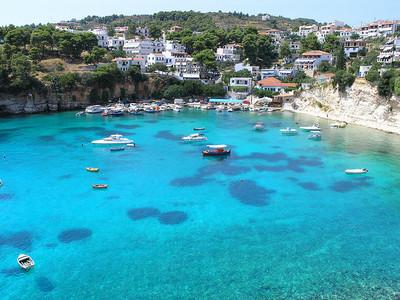 It started out as an experiment. Would I be able to travel with my six-year-old son, mother, and two aunts to a small Aegean island and actually be able to shoot a short documentary film about its ecotourism efforts in a week? The Greeks are known for many things – love of life, great food, proud history and genuine kindness, but they aren’t necessarily known for sticking to a timeline.
It started out as an experiment. Would I be able to travel with my six-year-old son, mother, and two aunts to a small Aegean island and actually be able to shoot a short documentary film about its ecotourism efforts in a week? The Greeks are known for many things – love of life, great food, proud history and genuine kindness, but they aren’t necessarily known for sticking to a timeline.
However, after a summer when the world was served numerous news stories about Greece’s near economic collapse and violent riots, I viewed it as a chance to both spend some special time with my family and shed some light on a little known good news story. Little did I suspect that the travel experience would energize me, educate my son and change a tiny island’s conservation funding prospects.
They certainly don’t make it easy to get to Alonissos. All told, the journey from Athens took two hours by bus and another three hours by boat – all of it extraordinarily scenic. We passed by some very picturesque islands including Skopelos (where the movie Mamma Mia was filmed) and, as we made our final approach toward Alonissos, some surprisingly choppy seas that reminded me of the movie Castaway, where the island was protected by a band of rough seas, yet also disconnected from the rest of the Aegean Sea.
words + photos by Noella Schink
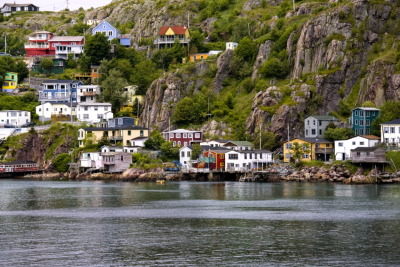 Most know of Newfoundland only because the Titanic almost made it there and… well, I guess that was the only time I’d heard of the island before I set off for it, backpack bulging. After hearing it was pretty, I decided I would travel there in an effort to unwind after my harrowing senior year. I wanted to rough it, explore new terrain; I was hopeful for a dose of nature’s rejuvenation after the fluorescent lockdown of high school.
Most know of Newfoundland only because the Titanic almost made it there and… well, I guess that was the only time I’d heard of the island before I set off for it, backpack bulging. After hearing it was pretty, I decided I would travel there in an effort to unwind after my harrowing senior year. I wanted to rough it, explore new terrain; I was hopeful for a dose of nature’s rejuvenation after the fluorescent lockdown of high school.
My month-long trip started in central Maine. It took 12 hours to drive into Canada, through quaint New Brunswick and rural Nova Scotia, to the furthest tip of Cape Breton Island where “Lick-a-Chick” fried chicken’s neon billboard came out of the misty night as the only sign of life aside from the ferry terminal. It was a six-hour, overnight ferry ride to Port-aux-Basques, Newfoundland.
The early morning fog did nothing to hinder my high spirits and I immediately took off on the scenic, albeit lonely, Trans-Canada Highway. I stopped at every brown and yellow Provincial Park sign, giddy for the start of my venture. J.T. Cheeseman gave me a chuckle with its goofy name, but the chilly tidepools and sweeping dunes were gorgeous. Little did I know the Newfie place names would only get quirkier as the scenery turned more dramatic.
Nicaragua: Can you keep a secret?
words + photos by Ellen Barone
Here's the truth: I want to tell you about Nicaragua and its wild, deserted Pacific beaches, active volcanoes, colonial cities, coffee plantations, and verdant mountains— but then again, I don't.
Writing about delicate cultures like Nicaragua, where complex political, geographical and economic realities have resulted in hardships on one hand - and a simpler, more grounded way of life on the other - always brings up mixed feelings in me.
words + photos by Katherine Braun Mankin
IN THE MIDDLE OF NOWHERE
I stared out into the empty plain of the Gran Sabana and thought about my husband, Don. I was glad that I wasn’t with him. He was at that moment climbing a tepui, a rocky, table top mountain. I didn’t want to climb the tepui. I don’t like walking uphill. I don’t like cold or wet places, and I especially don’t like cold and wet together. Sleeping on the ground hurts my back, and I prefer indoor plumbing to more rustic alternatives. And I’m a wilderness wimp. So, instead of hiking a tepui, I went to the middle of nowhere.
Photo Slide Show by Katherine Braun Mankin
The Gran Sabana in the southeastern corner of Venezuela, bordering Brazil, is a high plateau of wide savannah interrupted only by clumps of jungle, shadowy outlines of distant tepuis and many waterfalls. My husband and I were in Venezuela at the invitation of Venezuela Elite, a tour operator offering trekking, biking and cultural trips in the region and elsewhere (www.venezuelaelite.com). While my husband climbed the tepui, I spent a week in the Gran Sabana with a guide and a driver, staying at eco-camps or small hotels (indoor plumbing !), going on relatively easy hikes and visiting the indigenous people of this area. For a week I had the pleasure of looking out at landscapes that stretched endlessly into an uncluttered vista of land, sky and water.
words and photos by Don Mankin
CLIMBING AUYAN TEPUI
The wet, slanted face of the boulder looks treacherous. To make matters worse, the bottom edge hangs over a precipitous drop-off with nothing below but air. I’m not sure how I am going to work my way up its slippery surface. As Alejandro reaches his hand out to help me, my boots slip and I slide out of sight. For what seems like an eternity, I am in free fall, not sure how far I will fall or what I will land on when I hit bottom.
It was the third day of an 8-day trek up, on and down Auyan Tepui, the largest of the tabletop mountains of Venezuela (tepui means “house of the gods” in the language of the indigenous Pemon people). There are over 100 tepuis in SE Venezuela, ancient sandstone mesas that jut thousands of feet straight up from the jungle and savannahs below. The most famous tepui is Mt. Roraima, supposedly the inspiration for Sir Arthur Conan Doyle’s “The Lost World,” as well as for the hit animated movie, “Up.” Auyan Tepui is larger, more difficult to climb and receives far fewer visitors. It is also the source of Angel Falls (“Paradise Falls” in the movie, “Up”), the world’s highest waterfall at over 3000 feet. Since the tepuis are very old, the flora and fauna that have evolved on the tops of the tepuis are very different than those in the jungles and savannahs below. In fact, the tepuis are like islands in the sky, so each one has plants and animals unique to itself. One of the things they all have in common, though, is that there are no dinosaurs despite the fanciful speculations of Sir Arthur.
Newfoundland: Three Lifetimes in Three Days
by Jules Older
I'm a travel writer, which means I'm a hit-and-run artist — New Zealand’s North Island today, the southern Sierra tomorrow. I'm the man who rarely returns.
Except to Newfoundland. I've been five times to Canada's easternmost, poorest and most interesting province. That chunk of rock in the North Atlantic, closer to Ireland than to Vancouver, 1,600 miles east of New York, captured my heart an hour into my first visit.
On the latest visit, I experienced three lifetime thrills in three consecutive days. Where else on earth can you do that?
THRILL ONE: ICEBERGS
It began in the tiny town of Springdale, where we hooked up with ace pilot Rick Adams, owner-operator of Springdale Aviation Ltd.
I flew over and around massive icebergs making their way south from Greenland. Never before had I seen a berg, and now they were scant yards below the Cessna 185's wing.
But if iceberging from a low-flying plane is a thrill, berging from a sea kayak is a life event. Because sea kayaking has a very steep learning curve -- you can be moderately proficient in an hour or so -- and because icebergs have a tendency to get stuck just offshore in the province's protected harbors, the experience is open to the many rather than the fit few.
It's a stunning experience. I drove over a hill and down into an outport, Newfoundland for coastal village. My heart thumped a little louder as I spotted the gleaming white of half a dozen icebergs towering above the dark water like dollops of cream on a chocolate cake. I couldn't wait to haul the kayak off the roof of the van.
My personal Glacier Bay
Roar. We heard an earthquake-like rumble.
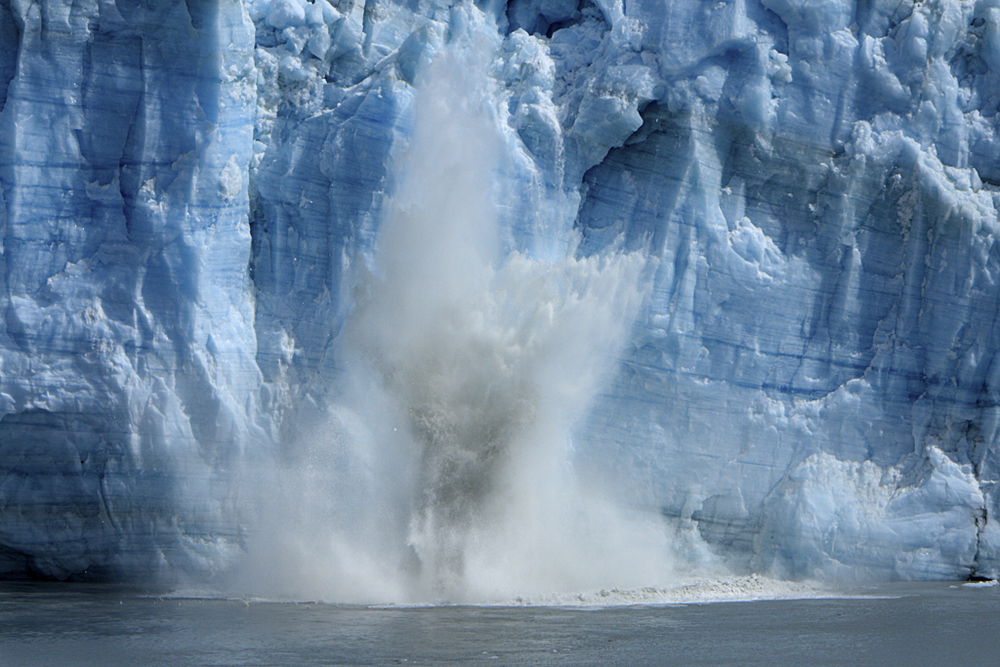 In Glacier Bay, an enormous, luminous, turquoise chunk sheared off the icepack and dropped in the water. The Grand Pacific Glacier calved before our eyes, as it had for John Muir on his Voyages of Discovery into Southeast Alaska. While Muir traveled by dugout canoe with the Tlingit Indians, we cruised on a small tour boat with a National Park Service naturalist.
In Glacier Bay, an enormous, luminous, turquoise chunk sheared off the icepack and dropped in the water. The Grand Pacific Glacier calved before our eyes, as it had for John Muir on his Voyages of Discovery into Southeast Alaska. While Muir traveled by dugout canoe with the Tlingit Indians, we cruised on a small tour boat with a National Park Service naturalist.
“Mom, it’s awesome!” Ben said. I shrugged as if to say he could find a better word. He answered, “Okay! It’s glorious!” My fourteen-year-old’s eyes sparkled with a three-year-old’s look of wonder. The weary look born by too many video games slipped away.
Whoosh. Waves caused by the crashing ice rocked our ship. Silently, we exchanged wide-eyed glances. Transfixed, we feasted our eyes on the moment in time.
Whirr. A chill wind whisked off the glacier, swept through our layers of tee-shirts, wool sweaters, and windbreakers, brushed and reddened our faces.
Life stopped in Glacier Bay in the ice age. Rivers that once cascaded to the Pacific Ocean froze in time. These days, the aqua ice is melting.
Remember? Memory whispered, Remember how you first saw this when you were a young journalist, single, and so full of dreams? Twenty some years had passed since a pilot friend had flown me to Gustavus, sending me on my first venture into Glacier Bay. Within a few years, I married, moved to California, became a mom, created a home, and taught school. In showing Alaska to Ben, I returned to a familiar place. I realized that I had revisited it many times. Memory had been my constant companion and Glacier Bay a favorite place to travel.


